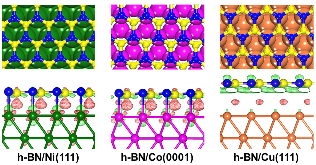Interface Engineering of Earth-Abundant Transition Metals Using Boron Nitride for Selective Electroreduction of CO2
- Univ. of California, Riverside, CA (United States). Dept. of Chemistry
- Oak Ridge National Lab. (ORNL), Oak Ridge, TN (United States). Chemical Sciences Division. Center for Nanophase Materials Sciences
- Oak Ridge National Lab. (ORNL), Oak Ridge, TN (United States). Chemical Sciences Division. Center for Nanophase Materials Sciences; Univ. of Tennessee, Knoxville, TN (United States). Dept. of Chemistry
Two-dimensional atomically thin hexagonal boron nitride (h-BN) monolayers have attracted considerable research interest. Given the tremendous progress in the synthesis of h-BN monolayers on transition metals and their potential as electrocatalysts, we investigate the electrocatalytic activities of h-BN/Ni, h-BN/Co, and h-BN/Cu interfaces for CO2 reduction by the first-principles density functional theory. We find that with the h-BN monolayer on the metal, electrons transfer from the metal to the interface and accumulate under the B atoms. By calculating the binding energies of three key intermediates (H, HCOO, and COOH) for hydrogen evolution and CO2 reduction, we find that H binding on the metal can be significantly weakened by the h-BN monolayer, preventing the hydrogen evolution reaction (HER). However, the binding strength of HCOO is strong on both the metal and h-BN/metal, especially for Ni and Co, promoting the CO2 reduction channel. On the basis of the free-energy diagrams, we predict that h-BN/Ni and h-BN/Co will have very good electrocatalytic activities for CO2 reduction to HCOOH, while the competitive HER channel is filtered out by the surface h-BN monolayer. Our study opens a new way for selective electroreduction of CO2 via the interface engineering of the h-BN/metal system.
- Research Organization:
- Oak Ridge National Laboratory (ORNL), Oak Ridge, TN (United States); Univ. of California, Riverside, CA (United States); Lawrence Berkeley National Laboratory (LBNL), Berkeley, CA (United States). National Energy Research Scientific Computing Center (NERSC)
- Sponsoring Organization:
- USDOE Office of Science (SC), Basic Energy Sciences (BES). Chemical Sciences, Geosciences, and Biosciences Division
- Grant/Contract Number:
- AC05-00OR22725; AC02-05CH11231
- OSTI ID:
- 1468197
- Alternate ID(s):
- OSTI ID: 1485129
- Journal Information:
- ACS Applied Materials and Interfaces, Vol. 10, Issue 7; ISSN 1944-8244
- Publisher:
- American Chemical Society (ACS)Copyright Statement
- Country of Publication:
- United States
- Language:
- English
Web of Science
Mo-doped boron nitride monolayer as a promising single-atom electrocatalyst for CO 2 conversion
|
journal | January 2019 |
Similar Records
Trends in Formic Acid Decomposition on Model Transition Metal Surfaces: A Density Functional Theory Study
Trends in Formic Acid Decomposition on Model Transition Metal Surfaces: A Density Functional Theory study










